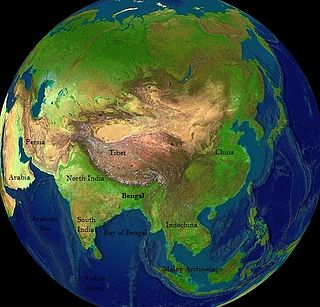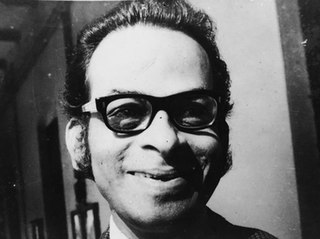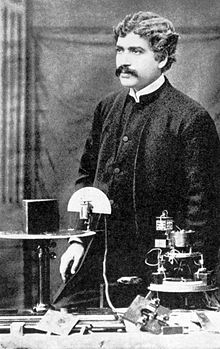
Bengal or endonym Bangla is a historical geographical, ethnolinguistic and cultural term referring to a region in the eastern part of the Indian subcontinent at the apex of the Bay of Bengal. The region of Bengal proper is divided between modern-day sovereign nation of Bangladesh and the Indian state of West Bengal.

Satyendra Nath Bose was an Indian theoretical physicist and mathematician. He is best known for his work on quantum mechanics in the early 1920s, in developing the foundation for Bose–Einstein statistics and the theory of the Bose–Einstein condensate. A Fellow of the Royal Society, he was awarded India's second highest civilian award, the Padma Vibhushan, in 1954 by the Government of India.

Sir Jagadish Chandra Bose (; IPA:[dʒɔɡodiʃtʃɔndroboʃu]; 30 November 1858 – 23 November 1937) was a polymath with interests in biology, physics, botany and writing science fiction. He was a pioneer in the investigation of radio microwave optics, made significant contributions to botany, and was a major force behind the expansion of experimental science on the Indian subcontinent. Bose is considered the father of Bengali science fiction. A crater on the Moon was named in his honour. He founded the Bose Institute, a premier research institute in India and also one of its oldest. Established in 1917, the institute was the first interdisciplinary research centre in Asia. He served as the Director of Bose Institute from its inception until his death.

Meghnad Saha was an Indian astrophysicist who helped devise the theory of thermal ionisation. His Saha ionisation equation allowed astronomers to accurately relate the spectral classes of stars to their actual temperatures. Saha's equation is considered one of the ten most outstanding discoveries in astronomy and astrophysics since Galileo's invention of the telescope in 1608. He was elected as an independent member to the Parliament of India in 1952.

The Bengal Renaissance, also known as the Bengali Renaissance, was a cultural, social, intellectual, and artistic movement that took place in the Bengal region of the British Raj, from the late 18th century to the early 20th century. Historians have traced the beginnings of the movement to the victory of the British East India Company at the 1757 Battle of Plassey, as well as the works of reformer Raja Rammohan Roy, considered the "Father of the Bengal Renaissance," born in 1772. Nitish Sengupta stated that the movement "can be said to have … ended with Rabindranath Tagore," Asia's first Nobel laureate.
Bose is either a Bengali Kayastha surname or a name of European origin, sometimes as von Bose or Bosé.

Bengalis, also rendered as endonym Bangalee, are an Indo-Aryan ethnolinguistic group originating from and culturally affiliated with the Bengal region of South Asia. The current population is divided between the sovereign country Bangladesh and the Indian regions of West Bengal, Tripura, Barak Valley, Goalpara, Andaman and Nicobar Islands, and parts of Meghalaya, Manipur and Jharkhand. Most speak Bengali, a language from the Indo-Aryan language family. Sub-section 2 of Article 6 of the Constitution of Bangladesh states, "The people of Bangladesh shall be known as Bengalis as a nation and as Bangladeshis as citizens."

Qazi Motahar Hossain was a Bangladeshi writer, scientist, statistician, chess player, and journalist.
Basu, also Bose, Boshu, Bosu, or Bosh, is a Bengali Kulin Kayastha surname originating from the Bengal region of the Indian subcontinent. The name stems from Vāsu, a term for God Viṣṇu, meaning 'dwelling in all forms'.

S. N. Bose National Centre for Basic Sciences (SNBNCBS) is an autonomous research institute dedicated to basic research in mathematics sciences under the Department of Science and Technology of Government of India. It is located in West Bengal, Salt Lake, Kolkata. This institute was named after the Indian scientist Satyendra Nath Bose and established in 1986. Chanchal Kumar Majumdar was the founder director of this institute.

The University of Dhaka is a public research university located in Dhaka, Bangladesh. It was established in 1921 as University of Dacca and it is the oldest active university in Bangladesh.

Bengali Americans are Americans of Bengali ethnic, cultural and linguistic heritage and identity. They trace their ancestry to the historic ethnolinguistic region of Bengal region in the Indian subcontinent, now divided in South Asia between Bangladesh and West Bengal of India. Bengali Americans are also a subgroup of modern-day Bangladeshi Americans and Indian Americans. Bengalis are also classified under Bangladeshi Americans. Significant immigration of Bengalis to the United States started after 1965.
Mitra, also called Mittra or Mitro, is a Bengali Hindu surname found mostly amongst the Bengali Kayastha community in the Bengal region of the Indian subcontinent. This surname also has a prevalence in Iran and is a popular Persian last name found in America. The surname may have been derived either from the Sanskrit word Mitra, meaning friend or ally, or from the name of an important Indo-Iranian deity in the Vedas and in ancient Iran.

Siva Brata Bhattacherjee (1921–2003)—sometimes spelt Sibabrata Bhattacherjee—was a professor of physics at the University of Calcutta. He studied with the physicist, Satyendra Nath Bose, under whose supervision he completed his doctoral thesis in solid-state physics at the University College of Science.

Bangiya Bijnan Parishad is a science organization founded by Satyendra Nath Bose in 1948. As a science organization, the Bangiya Bijnan Parishad led the Science-Movement. Nowadays, many science movement organization take the inspiration from Bangiya Bijnan Parishad directly or indirectly.

The University College of Science, Technology and Agriculture are two of five main campuses of the University of Calcutta (CU). The college served as the cradle of Indian Sciences by winning the Nobel Prize in Physics in 1930 and many fellowships of the Royal Society London.

Shamima Karim Choudhury is a Bangladeshi physicist, academician, researcher, and women-in-science advocate. She retired as a Professor from the Department of Physics, University of Dhaka on 30 June 2016 after 44 years of teaching and research. She supervised more than 70 Masters and MPhil students in Physics. She is a Fellow of Bangladesh Physical Society. She is a member of OWSD, IOP and many national science societies. She is the team Leader of WIP in Bangladesh. She worked as the Provost of Rokeya Hall and as Director of the Bose Centre for Advanced Study and Research in Natural Sciences at Dhaka University.















